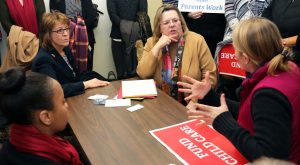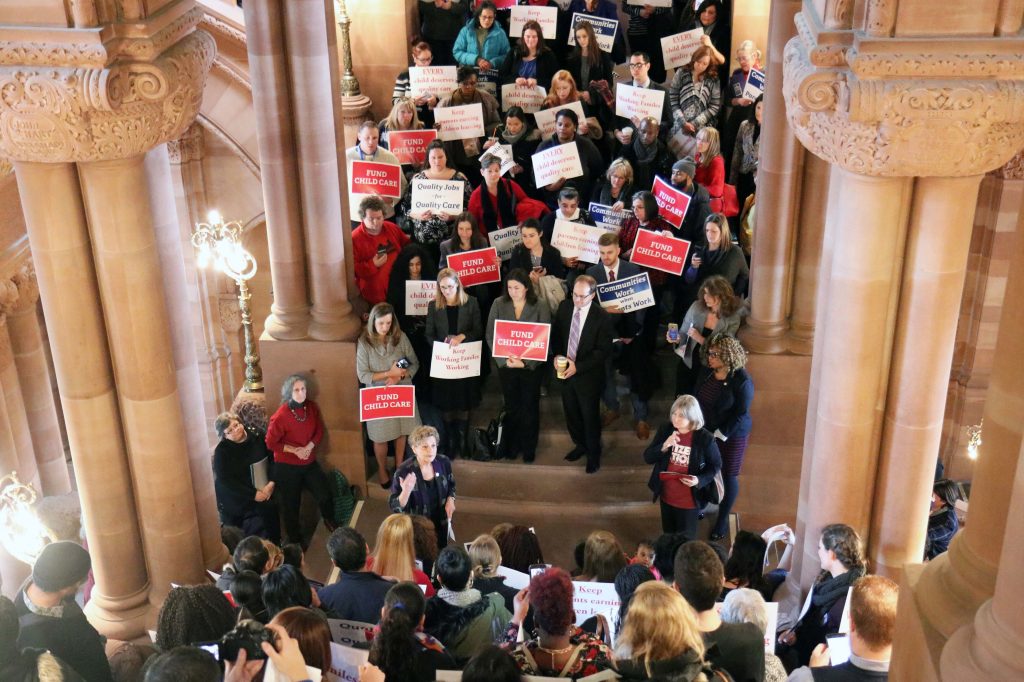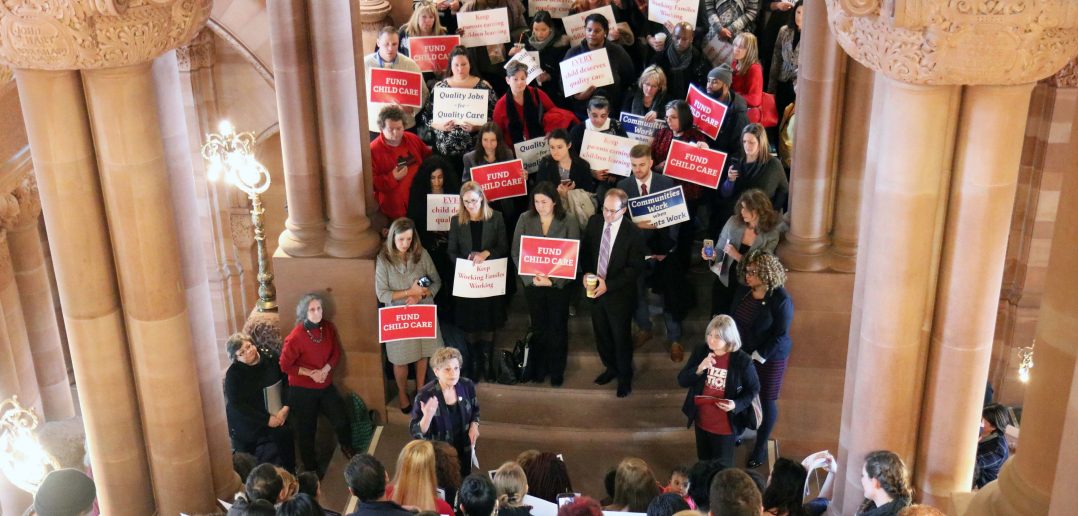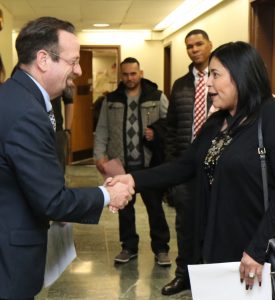
CSEA/VOICE 100A President Pam Wells and parent Samantha Mattison meet with Assemblymember Patricia Fahy’s chief of staff, Catherine Fahey, to discuss the need for adequate child care funding. Surrounding them are members of the Empire State Campaign for Child Care Coalition.
ALBANY — CSEA/VOICE Local 100A President Pam Wells recently closed her Group Family Child Care program in Washington County for the day and set out for the state Capitol in Albany.
There, she joined with other union members, parents and advocates to urge the state to fairly fund child care for New York’s working families. The day was organized by the Empire State Campaign for Child Care (ESCCC) and Union Child Care Coalition (UCCC).
Strain on families
With visits with legislators and a large midday rally planned, Wells brought Samantha Mattison, whose daughter attends Wells’ program, to tell her story.
Mattison lost her child care subsidy when an increase in her work hours raised her wages to just barely above what a parent can earn to be eligible for the program.
Earning more money, but not enough to afford child care, brought chaos and stress to Mattison’s life.
CSEA joins with new coalition, reaps gains for child care in New York
She took a second job and has only managed to stay afloat with support from her mother and Wells, who worked with Mattison to adjust her fee.
Many parents from across the state also traveled to Albany that day to tell legislators that a child care subsidy makes a big difference in the lives of their families: parents stay employed and are more productive at work, and children have consistent care that nurtures healthy development and learning.
New York’s underinvestment in child care means that only about 20 percent of eligible families get help to pay for care that rivals the cost of rent, mortgage and public college tuition. Providers struggle to stay open as operating costs outpace state reimbursement rates and what parents can afford to pay.
Wages are so low in the child care field that nearly 60 percent of people who teach and care for our youngest children are eligible for and participate in some type of public benefit. More than 60 percent of New Yorkers now live in what’s known as a child care desert — communities where there aren’t enough openings in child care programs to meet the need.
Working together
CSEA/VOICE Local 100A member Miriam Rodriguez also traveled from her Rochester Group Family Child Care program to Albany to talk with state lawmakers about the effects on providers and their small businesses.
“Although the recent minimum wage increase is wonderful news for working families and great progress for our state, it comes with a steep price for child care providers who employ assistants,” Rodriguez said.
Rodriguez also said the instability parents face is translated to instability for small child care businesses.
The Union Child Care Coalition has been a longtime force for affordable child care. Union leaders from across the state founded the Child Care Facilitated Enrollment Project — the only program of its kind in the United States — that strategically helps moderate income working families with child care and after-school care expenses. The program only operates in eight counties and several zip codes in New York City because it is not fully funded. Coalition members urged legislators to expand funding for child care facilitated enrollment so more working families can get help paying for child care expenses.
The Empire State Campaign for Child Care, made up of more than 75 organizations and growing, was formed last summer in response to a $7 million cut to child care subsidies in last year’s state budget. Bringing together hundreds of child care providers, parents, faith and union leaders across the state, the campaign succeeded in getting the governor to restore the $7 million cut to subsidies in the budget he released in January.

Advocates urge that care and safety of our children should be a top priority for elected officials and reflected in the state budget.
At the rally, parents, providers, advocates and legislators urged our leaders to do right by New York’s working families and youngest children: add $100 million in funding to help parents afford quality child care and support people who do the valuable work of teaching and caring for our youngest children.
“Parents, children and those of us working in the field pay a steep cost when New York doesn’t invest in child care,” Wells said.
Among others, Assemblymembers Ellen Jaffe, Kimberly Jean-Pierre and Harry Bronson and State Sen. Timothy Kennedy made firm commitments to work to increase New York’s investment in working families and our children through funding child care.
— Jill Asencio



